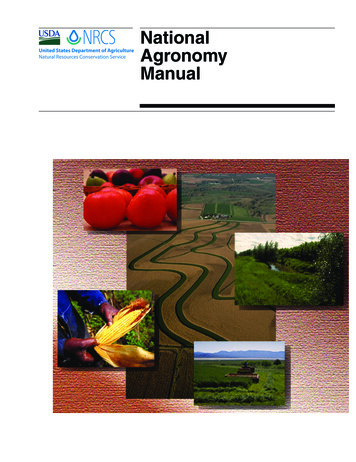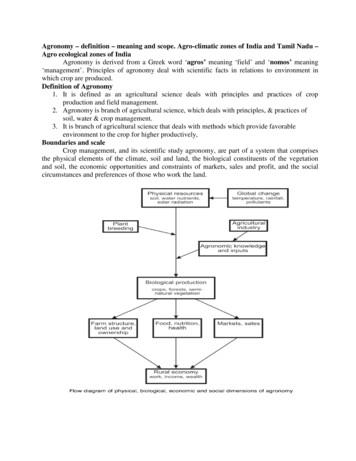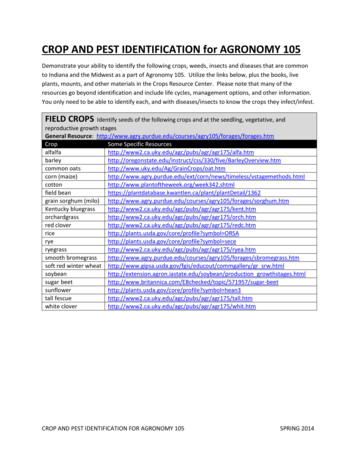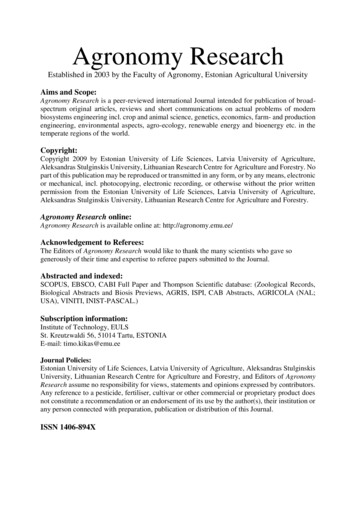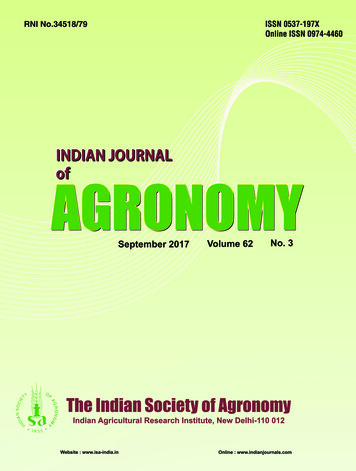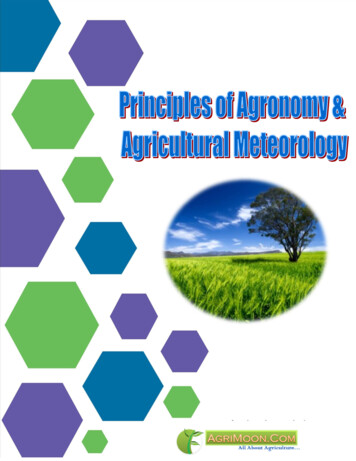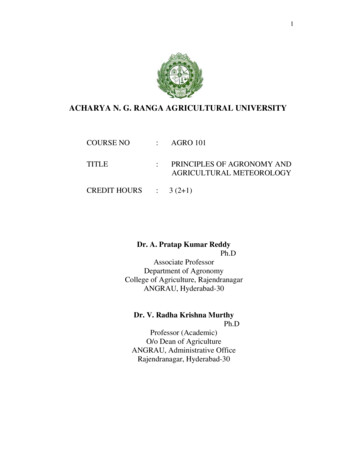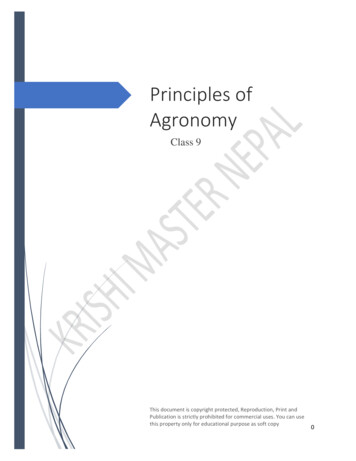
Transcription
Principles ofAgronomyClass 9This document is copyright protected, Reproduction, Print andPublication is strictly prohibited for commercial uses. You can usethis property only for educational purpose as soft copy0
Secondary Level for Grade - 9 (Technicaland Vocational Stream)Principles of Agronomy(Plant Science)2073Government of NepalMinistry of EducationCurriculum Development CentreSanothimi, BhaktapurSecondary Level for Grade - 9(Technical and Vocational Stream)1
Principles of Agronomy(Plant Science)Written By:Balachandra ChaulagaiAnil Kumar AcharyaMahesh PaudelSujan KarkiGovernment of NepalMinistry of EducationCurriculum Development CentreSanothimi, BhaktapurTable of contentUnit1ScopeIntroduction toAgronomyContentPage1.1. Introduction to agriculture.1.2. Definition of agronomy.1.3. Importance of agronomy and its role in Nepalesecontext.1.4. Agronomical classification of field crops.1.5. Relation between agronomy & other crop science.2
Climate22.1. Defination of climate & weather2.2. Types of climate2.3.Classification of different climatic zones & crops.2.4. Effect of climate on crop production .3FarmMechanization3.1 .Definition & concept3.2 .Advantages & disadvantages .3.3. Hand, Bullock, drawn & power operation equipment3.4. seed dril /seed cum fertilizer dril machine3.5. Harvester3.6. Thresher & cleaner4Soilmanagement54.1. Tillage4.1.1. Definition and importance of tillage4.1.2. Types of tillage and advantages andlimitation of different types of tillage4.1.3. Tillage practice in our countryCropping5.1. Definition of cropping system& cropping patternSystem5.2. Mono cropping5.3 Mixed & relay cropping5.4. Inter & multiple cropping5.5. Cropping scheme & crop rotation5.6. Cropping intensity5.7.Cropping index & Harvesting Index6WaterManagementTwo aspect of soil management would beconsidered in this topic:6.1 Irrigation6.1.1. Introduction6.1.2. Importance of water in crop life.6.1.3. Types of irrigation system practiced in Nepal6.1.4.Critical stages of moisture requirement in majoragronomical crops6.2. Drainage:6.2.1. Concept of drainage and drainage system6.2.2. Objective and importance of drainage in cropproduction6.2.3 . Adverse of effect poor drainage in cropproduction6.2.4. Rain water harvest technique3
7Seed and seedquality7.1. Meaning of seed and characteristics of quality seed.7.2 Types of seed7.3. Importance of quality seed in crop yield.7.4. Quality seed production and method of seedcertification.7.5. General concept of seed/gene bank, patent right.8Post HarvestHandling8.1. Concept of Post Harvest Handling8.2. Importance of proper post harvest handling.8.3. Method of properpost harvest handling forconsumption purpose and seed purposeUnit-1 AgronomyLearning Outcomes:-After completion of this unit student will be able to:- Demonstrate the understanding of meaning, concept, importance and scope of agriculture.- Explain the meaning, concept, importance and scope of agronomy.IntroductionAgriculture is a biological production process which depends on the growth and development ofselected plants and animals within the local environment. The history of agriculture began morethan 10,000 years ago. It is believed that the transformation from hunting- gathering to agricultureoccurred gradually after a long period of time. Several theories were advanced to shed light on thehistory of agriculture, particularly how it started. Agriculture has three main spheres they areGeoponic (cultivation in the earth soil), Aeroponic (cultivation in air) and Hydroponic (cultivationin water). Agriculture is the branch of science encompassing the applied aspects of basic sciences.The applied aspect of agricultural science consists of study of field crops and their managementsincluding soil management. Agriculture plays a crucial role in the life of an economy. It is thebackbone of Nepalese economy system. Agriculture helps to meet the basic need of humans and4
their civilization by providing food, cloth, shelter, medicine and recreation. Nepal is known as anagricultural country. Near an about 66% of Nepalese population depends upon agriculture.Agriculture is the dominant sector of our economy and contributes in various ways.Agronomy is a branch of agricultural science which deals with principles and practices of fieldcrop production. Agronomy is mainly based on following basic principles Sustainable Agriculture,Agrometerology, Soils and Tillage, Soil and Water Conservation, Dry LandAgriculture, Mineral Nutrition of Plants, Manures and Fertilizers, Irrigation Water Management,Weed Management, Cropping Systems, Cropping Scheme, Crop Rotation. Agronomy is thescience and technology of using plants for food, fuel, feed, fiber, reclamation. Among all thebranch of agricultural, agronomy occupies vital position and is called the mother branch orprimary branch. Crop classification is a systematic grouping of crops based on oil demarcatedcharacteristic. Knowledge of crop classification helps grower and concern people to generalizedsimilar crops as a class of group for attaining a better understanding about them. Agronomicalcrops can be classified in several groups: botanical, descriptive and agricultural basis.Definition of AgricultureThe word agriculture comes from the Latin words ager, meaning soil and cultura, meaning cultivation.It is a very broad term, which includes Crop production, Animal Husbandry and Dairy Science,Agriculture Chemistry and Soil Science, Horticulture, Agril-Economics, AgrilEngineering,Botany, Plant Pathology, Extension Education and Entomology, which develops its separate anddistinct branches of agriculture. Agriculture is defined as science, art and business of producingcrops or animals under human supervision. It is channeling the incoming solar energy into crops/livestock through efficient management practices. Agriculture is a biological production processwhich depends on the growth and development of selected plants and animals within the localenvironment. Several authors have defined agriculture in different ways. Some of them are: According to Rimando, T.J 2004 "Agriculture is the systematic raising of useful plantsand livestock under the management of man". According to Abellanosa, A.L and H.M. Pava 1987 "Agriculture is the growing of bothplants and animals for human needs". According to Rubenstein, J.M 2003 "Agriculture is the deliberate effort to modify aportion of Earth's surface through the cultivation of crops and the raising of livestock forsustenance or economic gain". According to Miller V. Dixon "Agriculture is the science of cultivating the soil,harvesting crops and raising livestock and also as the science or art of the production ofplants and animals useful to man and in varying degree the preparation of such productsfor man's use and their disposal".History of AgricultureThere are many options for those wishing to study an agriculture-based degree due to the nature ofthe breadth of the subject. It is generally accepted that the history of agriculture began more than10,000 years ago. But without written records, the evolution of agriculture can only be5
reconstructed through deductions using logic. It is believed that the transformation from huntinggathering to agriculture occurred gradually after a long period of time. Several theories wereadvanced to shed light on the history of agriculture, particularly how it started. Some of historicalevents that occur in agriculture are: In pre scientific agriculture six persons could produce enough food for themselves and forfour others. In years of bad harvest they could produce only enough for themselves, withthe development of science and application of advanced technology five persons are ableto produce enough food for nine others. Van Helmet (1577-1644AD): Experiments pertaining to plant nutrition in systematic wayand concluded that the main “Principle” of vegetation is water. Jethre Tull (1674-1741AD): Conducted several experiments and published a book “HorseHoeing Husbandry”. These experiments were mostly on cultural practices and they led tothe development of seed drill & horse drawn cultivation. Aurthur young (1741-1820AD): Conducted pod culture experiments to increase the yieldof crops by applying several materials like poultry dung, litter, gun powered, and publishhis work-in 46 volumes on “Annals of agriculture”. In 1809 soil science began with the formulation of the theory of humans. Research inplant nutrition and physiology was started in 18th century. Sir Humphrey Davy published book “Elements of Agri chemistry” in 1813. Sir John Bennet was begun to experiment on the effects of manures of crops. Justus Libey on agriculture chemistry and physiology launched systematic development ofagriculture in 1840. 1842, Initiated the systematic fertilizers Industry by the patented process of heartingphosphate rock to produce super phosphate. Gregor Johann Mendel (1866) discovered the law of heredity and the ways to mutationslaid to modern plant breeding. Charles Darwin published the results of the experiments on cross and self ferlization inplants. 1920: application of genetics to develop new strains of plants and animals brought majorchanges in agriculture. The first successful tractor was built in U.S in 1882 from implements and machinery wasmanufactured industrially on a large scale by 1930. Due to economic pressure and decrease in labor availability, electricity was applied inagriculture in 1920. The first successful large scale conquest of a pest as chemical means was the control ofgrapevine powdery mildew in Europe in 1840. The key date in history of agriculture research at education is 1862. When the US congressset up departments of agriculture & provided for colleges for agriculture in each state.6
Agricultural Revolutions Green Revolution: The Green Revolution refers to a set of research anddevelopment of technology transfer initiatives occurring between the 1930s andthe late 1960s that increased agricultural production worldwide. Brown Revolution: This revolution is related to fertilizer production. Round Revolution: This revolution is related to potato production.Branches of AgricultureAgriculture has three main spheres. They are Geoponic (cultivation in the earth soil), Aeroponic(cultivation in air) and Hydroponic (cultivation in water). Agriculture is the branch of scienceencompassing the applied aspects of basic sciences. The applied aspects of agricultural scienceconsist of study of field crops and their managements including soil management. The branches ofagriculture are as follows:i) Crop Production:It deals with the production of various crops, which includes food crops, fodder crops, fiber crops,sugar, oil seeds etc. It includes agronomy, soil science, entomology, pathology, microbiology, etc.The aim is to have better food production with better management practices. ii) Horticulture:It deals with the production of flowers, fruits, vegetables, ornamental plants, spices, condiments,beverage, medicinal plants and their postharvest preservation. iii) Agricultural Engineering:It is an important component for crop production and horticulture particularly to provide tools andimplements. iv) Agro-Forestry:It is a method and system of land management involving the simultaneous. It involves thecultivation of farm crops and trees agriculture incorporating thegrowing of trees.v) Animal Husbandry:The animals being produced, maintained, etc. Maintenance of various types of livestock for directenergy. Husbandry is common for both crop and animals. The objective is to get maximum outputby feeding, rearing etc.Importance of AgricultureAgriculture plays a crucial role in the life of an economy. Agriculture is the backbone of Nepaleseeconomy system. Agriculture helps to meet the basic needs of humans and their civilization byproviding food, cloth, shelter, medicine and recreation. Hence, agriculture is the most important7
enterprise in the world. The followings facts clearly highlight the importance of agriculture in ourcountry.i) Source of FoodAgriculture is determined as the main source of food in Nepal. All food and cash crops are grownfrom agriculture. Agriculture is the mean to survive. We get all required food from it. So, it is amain source of food. ii) Source of Raw MaterialAgriculture is not only the source of food but a dominant source of raw material. Jute, sugarcane,tobacco, etc. are produced or obtained from agriculture.iii) Employment OpportunitiesAgriculture sector is the primary source of employment. About 65 % of total Nepalese populationdepends upon agriculture. Thus, almost all farmers are completely engaged in agriculture, makingagriculture dominant in agricultural employment. iv) Source of Foreign TradeMost of the agro-products are exported to foreign or international market. About 60% of the agroproduct is exported to foreign land. They include tea, coffee, woolen clothes, leather jackets etc.v) Increase in Government RevenueSince, 60% of goods exported are obtained from agriculture. So, Government of Nepal includesexport tax, tax, registration tax etc. which is the important source of Government revenue. vi)Significance in TransportBulks of agricultural products are transported by roadways from farms to factories. Mostly, internaltrade is in agricultural products. Moreover, the revenue of the government, to a larger extent, relieson the success of agricultural sector.vii) Economic DevelopmentSince agriculture employs many people, it contributes to economic development. As a result, thenational income level as well as people’s standard of living are improved. The fast pace ofdevelopment in agricultural sector offers progressive outlook as well as increased motivation fordevelopment. Hence, it aids to create good atmosphere for overall economic development of acountry. Therefore, economic development relies on the agricultural growth rate.viii) Source of SavingDevelopment in agriculture may also increase savings. The rich farmers we see today started savingparticularly after green revolution. This surplus quantity may be invested further in the agriculturalsector to develop the sector.ix) Food SecurityA stable agricultural sector ensures a nation of food security. The main requirement of any countryis food security. Food security prevents malnourishment that has traditionally been believed to beone of the major problems faced by the developing countries. Most countries rely on agriculturalproducts as well as associated industries for their main source of income.8
Scope of AgricultureProverbially, Nepal is known an agricultural country. Majority of Nepalese people depend uponagriculture. Agriculture is the dominant sector of our economy & contributes in various ways suchas:i) National Economy:Agriculture is a major source of income for national economy. Adoption of commercialagricultural produce having high economic value helps to earn the national economy. Agriculturalsector only contributed 33% of the GDP, while non agricultural sector contributed 67%. Itindicated that the more the advanced the stage of development the smaller is the share ofagriculture in National Income. ii) Total Employment:Around 65% of the total population is working and depends on agriculture and allied activities.Nearly 70% of the rural population earns its livelihood from agriculture and other occupation alliedto agriculture. In cities also, a considerable part of labor force is engaged in jobs depending onprocessing and marketing of agricultural products. iii) Industrial Inputs:Most of the industries depend on the raw material produced by agriculture, so agriculture is theprincipal source of raw material to the industries. The industries like cotton textile, jute, paper,sugar depend totally on agriculture for the supply of raw material. The small scale and cottageindustries like handloom and power loom, ginning and pressing, oil crushing, rice husking,sericulture, fruit processing, etc are also mainly agro- based industries. iv) Food Supply:Agriculture sector is only the way to supply food material for people. During the fiscal year2072/73 the food production was 8614283 metric tons, which has to be increased to feed thegrowing population. Nepal, thus, is able to meet almost all the needs of its population with regardsto food by developing intensive programes for increasing food production. v) Trade:Agriculture plays an important role in foreign trade, attracting valuable foreign exchanges,necessary for our economic development. The product from agriculture- based industries such asjute, cloth, tinned food, etc can be exported. Other agricultural products like cardamom, coffee,ginger,oil seed , spices, tea, tobacco, etc also constitute the main items of export from Nepal.Features of Agriculture in Nepali) Subsistance Farming:Nepal carries out subsistance farming rather than commercial. Majority of Nepalese farmers adoptsubsistance farming and do not export their surplus; this does not prevent a minority in the fertile southernTerai region from being able to do so. Most of the country is mountainous, and there are pockets of fooddeficit areas. It is far easier to export across the border to India than to transport surplus to remotemountainous regions within Nepal. ii) Monsoon-based Agriculture:Majority of Nepalese farming system depends upon monsoon. No proper irrigation facilities havebeen made by the government of Nepal. Besides, the geographical structure of hills and mountainscomes in the way of irrigation management.9
iii) Pre-dominance of Food CropsFood crops are the type of crops that are basically used as primary sources of food. They includepaddy, maize, etc. Nepal has long been growing lots of food crops and today also it shares around48.9% of the requirement.iv) Traditional TechnologyNepal is practicing traditional method of farming system till now. Unavailability of moderntechnology and high price of machinery equipment have led to the low adaptation of moderntechnology.v) Low ProductivityIt’s obvious to have low productivity because farmers entirely depend upon monsoon rain, whichis uncertain. Lack of proper irrigation facilities, improved seeds, fertilizers and traditional methodof farming cause low production.Problems of Agriculture in Nepali) Poor PeopleThe economic status of the rural mass in this country as compared to developed or a developingcountry is very low. Most of the agronomical crops require intensive cultivation practices thatinvolves costly inputs.ii) Small Land Holding and AcreageMajority of Nepalese people have fragmented and scattered land owing to high population growthrate and continuous family separation. Thus the average land holding size per family is just 0.68ha.Most of the agronomical crops require a larger area for commercial production that helps to fulfillthe food requirement.iii) Lack of IrrigationIrrigation is the basic infrastructure for agricultural development. About 20% of the total arableland irrigation facility while the remaining area entirely depends upon monsoon rain.iv) Lack of TechnologyNepal is one of the least developing countries in the world. About 21.6% of total population liveunder the poverty line. So, neither they can afford for new technology nor they have properknowledge about it. So, our agricultural sector is lacking behind.10
Definition of AgronomyAgronomy is a branch of agricultural science which deals with principles and practices of fieldcrop production. It can also be defined as the branch of agricultural science which deals with themanagement of the field to provide favourable environment to the crop for higher productivity interms of both quantity and quality . The term is derived from Greek words "agros" meaning "field"and "nomos", meaning "to manage". The meaning of word agronomy can be elaborated from eachalphabet like A Activities (on), G Ground (for), R Raising, O Out spread use (of), N Noblecrops (for), O Obtaining, M Massive, Y Yield.Norman (1980) defined agronomy as the science of manipulating the crop environment complexwith dual aims of improving agricultural productivity and gaining a degree of understanding of theprocess involved.In the present context where environmental degradation food quality and economy are the majorconcerns, agronomy may be defined as the art and science of producing field crops which has theaim of increasing productivity and quality of product in order to maximize monetary return byminimizing the negative effect on the environment.Principle of AgronomyAgronomy is mainly based on the following basic principles.They are:# Sustainable Agriculture.#Agrometerology#Soils and Tillage.#Soil and Water Conservation.# Dry land Agriculture.#Mineral Nutrition of Plants.# Manures and Fertilizers.# Irrigation Water Management.# Weed Management#Cropping Systems.#Cropping Scheme.# Crop Rotation.11
i) Sustainable Agriculture:Sustainable agriculture can be defined as the form of agriculture aimed at meeting the food andfuel needs of the present generation without endangering the resource base for the futuregenerations. It is an act of farming that uses principles of ecology, the study of relationshipbetween organisms and their environment. It includes study of Impact of Improved CropProduction Technology, Factors Affecting Ecological Balance, Evaluation of SustainableAgriculture, Components of Sustainable Agriculture, Sustainable Utilization of Land Resources,Sustainable Utilization of Water Resources, Sustainable utilization of Biodiversity, IntegratedNutrient Management, Integrated Plant Protection, Enhancing Sustainability of Dry LandAgriculture, Enhancing Sustainability of Irrigated Agriculture, Agricultural Sustainability andFarming Systems.ii) Agrometerology:Agrometerology is the branch of meteorology which investigates the relationship of plants andanimals to the physical environment. Agrometerology describes agrometerological observatory,atmosphere, wind, clouds and precipitation, solar radiation, air temperature, soil temperature,humidity and evaporation, weather hazards and their mitigation, weather and crop productivity,weather relations of crops, weather forecasting and classification of climate and agro climate inrelation to agriculture. iii) Soils and Tillage:Soils and tillage are necessary to know how soils should be managed and conserved for sustainablecrop production. Under this principle of agronomy we can learn physical and chemical propertiesof soil, biological properties of soil, soil organic Matter, salt affected soils, and tillage.iv) Soil and Water Conservation:We must conserve soil and water because these are the most critical resources. In this principle wewill touch upon soil erosion, water erosion, wind erosion, soil and water conservation measure.v) Dry land Agriculture:Dry land agriculture is the practice of the agricultural production under rain fed condition.Itevolved as a set of techniques and managment practices used by farmers to continuously adapt tothe presence or lack of moisture in a given crop cycles.In marginal regions, a farmer should befinancially able to survive occasional crop failures, perhaps for several years in succession.vi) Mineral Nutrition, Manures and Fertilizer:Nutrient Management is one of the most important principles in agronomy which includesEssentials Plant Nutrition, Nutrient Uptake by Plants, Soil Fertility Evaluation, Manures,Fertilizers in Nepalese Agriculture, Nitrogen Fertilizers, Phosphatic Fertilizers, Potassic12
Fertilizers, Calcium, Magnesium and Sulphur, Micronutrients, Mixed Fertilizers, FertilizerApplication, and Fertilizers & Environment. vii) Irrigation Water Management:Irrigation Water Management is very important for the success of agriculture. The availability ofwater influences almost all the biochemical and physiological processes in plants which in turnaffects the morphology of plants. All the crop plants have an optimal moisture regime and anydeviation from the optimum results in adverse effect leading to poor growth, yields and even thequality of the produce. It is therefore necessary that an ideal soil moisture level be maintained forbetter growth, yields and quality of crops through proper water management practices. viii) WeedManagement:Weeds are plants that grow at a place where they are not desired. A weed can also be defined asan unwanted plant in the crop field. Weed interferes with agricultural operations and reduces theyield of crops. It competes with main crops for space, light, nutrient, moisture and more soharbours a pests and diseses. Weed management is one of the most important aspect of good cropproduction.It can be controlled efficiently by different methods such as cultural, mechanical,biological and chemical methods. ix) Cropping Systems:Cropping systems means a set of interrelated components and their interaction among themselves.The objective of any cropping system is efficient utilization of all resources viz., land, water andsolar radiation. It includes various terminology, major csystems, and agronomy of rain fedcropping systems, agronomy of irrigated cropping systems, evaluation of cropping systems,farming systems and farming systems research.x) Cropping Scheme:The cropping scheme is a plan in which crops are grown on individual plot of a farm during agiven period of time with the objective of obtaining maximum return from each crop without anyloss of soil fertility. The cropping scheme is related to the most profitable use of resources, land,labour, capital and management so that maximum net income may be obtained from the farm as awhole, with proper restoration of soil fertility. xi) Crop Rotation:Crop rotation refers to the growth of two or more crops in rotation - one after another - on thesame piece of land. It is a process of growing different crops in succession on a piece of land in aspecific period of time, with an objective to get maximum profit from least investment withoutimpairing the soil fertility.Importance of Agronomy and its Role in Nepalese ContextAgronomy is the science and technology of using plants for food, fuel, feed, fiber, reclamation.Among all the branches of agriculture, agronomy occupies vital position and is called mother13
branch or primary branch. Agronomy is a synthesis of several branches like crop science, whichincludes plant breeding, crop physiology, biochemistry and soil science, which includes soilfertilizer, manures, environmental science, meteorology and crop ecology. So agronomy is animportant sector of agricultural science. The importance of agronomy can be described underfollowing headings.i) Source of Food:Agronomical crops play a vital role in food supply. Majority of Nepalese farmers adopted the foodcrops for supplement of food material for daily requirement. Agronomical crops include majorfood crops such as rice, wheat, maize, barley, finger millet, potato etc. Similarly larger amount ofagronomical crops are used as a source of food for animals. ii) Source of Raw materials:Agronomical crops are the major source of raw material for agro-based industries. A number oflarger industries in the country depend upon the raw materials produced from agronomical crops.E.g. sugarcane for sugar industry, tobacco leaf for tobacco industry, paddy for rice mill etc.iii) Employment opportunitiesAgronomy is the primary source of employment opportunities. Agronomical crops demand morelabour for care in each and every aspect of cultivation, right from site selection to harvesting,processing, marketing and storage. All such factors create a great employment opportunities forthe working people.iv) Nutritional Supply:Agronomical crops are the major source food to the human being as well as animals which supplylots of nutrients including carbohydrate, protein, fat, lipids, vitamins, minerals nutrient etc. Cerealssuch as rice, maize, wheat, finger millet etc are good sources of carbohydrate; legumes crops suchas lentil, chickpea, pigeon pea, etc are good sources of protein, oilseed crops such as rapeseed,sunflower, mustard, groundnut, etc are good sources of fat and lipids as well Many otheragronomical crops are rich sources of mineral nutrients.v) Food SecurityA stable agronomical crop sector ensures a nation of food security. The main requirement of anycountry is food security. Food security prevents malnourishment that has traditionally beenbelieved to be one of the major problems faced by the developing countries. Agronomical cropsplay a vital role in food security by supplying a larger amount of food material because majorityof Nepalese people can easily produce the food crops to ensure the food security in rural as wellas urban areas.14
vi) Soil Conservation and Soil fertilityNepal is a mountainous country where large farming practice is adopted in sloppy areas which arehighly prone to soil erosion. So agronomical crops especially leguminous crops has the bestsolution to protect soil erosion by adopting different agro-technic such as cover cropping, stripcropping etc. Similarly, cultivation of agronomical crop through the crop rotation helps to enhancethe soil fertility status. Grain legumes and other plants of family leguminosae has an ability to fixthe atmospheric nitrogen in the soil through symbiosis with nitrogen fixing bacteria which isimportant in soil fertility improvement as well as supplement of nitrogen to the nitrogen deficientsoil.Agronomical Classification of field CropsClassification may be defined as the act of distributing things of the same type into classes orcategories. . Crop classification is a systematic grouping of crops based on well- demarcatedcharacteristics. Knowledge of crop classification helps growers and concerned people togeneralize similar crops as a class of group for attaining a better understanding about them.Agronomical crops can be classified in several classes or groups depending on the basis ofcl
Principles of Agronomy (Plant Science) Written By: Balachandra Chaulagai Anil Kumar Acharya Mahesh Paudel Sujan Karki Government of Nepal Ministry of Education Curriculum Development Centre Sanothimi, Bhaktapur Table of content Unit Scope Content Page 1 Introduction to Agronomy 1.1. Introduction to agriculture. 1.2. Definition of agronomy. 1.3.

